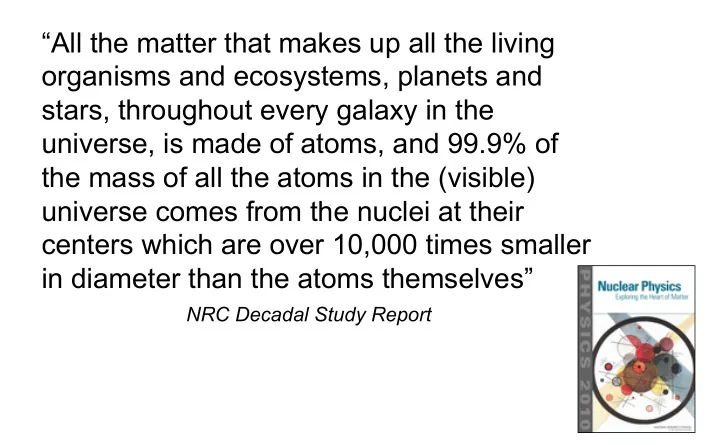

“All the matter that makes up all the living organisms and ecosystems, planets and stars, throughout every galaxy in the universe, is made of atoms, and 99.9% of the mass of all the atoms in the (visible) universe comes from the nuclei at their centers which are over 10,000 times smaller in diameter than the atoms themselves” NRC Decadal Study Report
But … Dark matter and dark energy together make up some 96% of the universe http://astronomy2009.nasa.gov/topics_oct.htm
The Quantum Ladder Galaxy clusters macroscopic Galaxies Stars Planets Living Organisms, Man-made Structures Cells, Crystals, Materials reduction complexity Molecules Atoms Nuclei subatomic Elementary Particles Quarks and Leptons (baryons, mesons) Super- strings ? ???
Nuclear Physics in the Universe: The Big Bang timeline, from inflation to quark soup to the birth of the light nuclei to the formation of atoms and gravitationally bound structures. http://www.lbl.gov/abc/wallchart/ Image: Particle Data Group/Lawrence Berkeley National Laboratory
The Nuclear Landscape and the Big Questions (NAS report) • How did visible matter come into being and how does it evolve? • How does subatomic matter organize itself and what phenomena emerge? • Are the fundamental interactions that are basic to the structure of matter fully understood? • How can the knowledge and technological progress provided by nuclear physics best be used to benefit society? The Mission: Explain the origin, evolution, and structure of the baryonic matter of the universe - the matter that makes up stars, planets, and human life itself
Su bfields of nuclear physics • nuclear structure, whose goal is to build a coherent framework for explaining all properBes of nuclei and nuclear maXer and how they interact • nuclear astrophysics, which explores those events and objects in the universe shaped by nuclear reacBons • hot QCD, or relaBvisBc heavy ions, which examines the state of melted nuclei and with that knowledge seeks to shed light on the nature of those quarks and gluons that are the consBtuent parBcles of nuclei • cold QCD, or hadron structure, which explores the characterisBcs of the strong force and the various mechanisms by which the quarks and gluons interact and result in the properBes of the protons and neutrons that make up nuclei. • fundamental symmetries, those areas on the edge of nuclear physics where the understandings and tools of nuclear physicists are being used to unravel limitaBons of the Standard Model and to provide some of the understandings upon which a new, more comprehensive Standard Model will be built. s o n v a t i e r b s O Reactive Beams Electron UTION UTION Scattering RESOLUT RESOLUT TANCE TANCE CE CE DISTA DISTA DI DI Relativistic Heavy Ions protons & neutrons
The scientific agenda (questions that drive the field) PERSPECTIVES ON THE STRUCTURE OF ATOMIC NUCLEI • What are the limits of nuclear existence and how do nuclei at those limits live and die? • What do regular patterns in the behavior of nuclei divulge about the nature of nuclear forces and the mechanism of nuclear binding? • What is the nature of extended nucleonic matter? What are its phases? • How can nuclear structure and reactions be described in a unified way? • How can the symbiosis of nuclear physics and other subfields be exploited to advance understanding of all many-body systems? NUCLEAR ASTROPHYSICS • How old is the universe? • How did the elements come into existence? • What makes stars explode as supernovae, novae, or X-ray bursts? • What is the nature of neutron stars? • What can neutrinos tell us about stars?
EXPLORING QUARK-GLUON PLASMA • What are properties of near-perfect liquid QGP • What is the origin of confinement? • What are the properties of the QCD vacuum? What is the origin of chiral symmetry breaking? • What are the experimental signatures for a transition to new phases in relativistic heavy-ion collisions? • What are the implications for the analogous epoch in the Big Bang? THE STRONG FORCE AND THE INTERNAL STRUCTURE OF NEUTRONS AND PROTONS • What are the internal structural properties of protons and neutrons and how do those properties arise from the motions and properties of their constituents? • How do those properties change when protons and neutrons are combined into complex nuclei? • Can QCD describe the full spectrum of hadrons in both their ground and excited states? • How do the nucleonic models emerge from QCD?
FUNDAMENTAL SYMMETRIES • What is the nature of the neutrinos, what are their masses, and how have they shaped the evolution of the cosmos? • Why is there now more visible matter than antimatter in the universe? • What are the unseen forces that were present in the dawn of the universe but disappeared from view as it evolved? Once very hot and very homogeneous, the universe now displays a preferred “handedness” and so the existence of lost forces. • What are the low-energy manifestations of physics beyond the Standard Model? How can precision experiments in nuclear physics reveal them? One Force ??
The Scale of the Universe http://htwins.net/scale2/
Recommend
More recommend